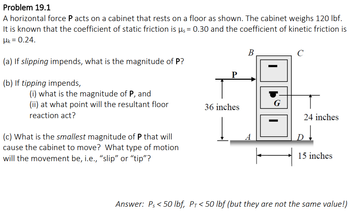
Elements Of Electromagnetics
7th Edition
ISBN: 9780190698614
Author: Sadiku, Matthew N. O.
Publisher: Oxford University Press
expand_more
expand_more
format_list_bulleted
Concept explainers
Question

Transcribed Image Text:Problem 19.1
A horizontal force P acts on a cabinet that rests on a floor as shown. The cabinet weighs 120 lbf.
It is known that the coefficient of static friction is µ = 0.30 and the coefficient of kinetic friction is
HK = 0.24.
(a) If slipping impends, what is the magnitude of P?
(b) If tipping impends,
(i) what is the magnitude of P, and
(ii) at what point will the resultant floor
reaction act?
(c) What is the smallest magnitude of P that will
cause the cabinet to move? What type of motion
will the movement be, i.e., "slip" or "tip"?
P
36 inches
B
I
G
с
т
24 inches
15 inches
Answer: Ps <50 lbf, PT < 50 lbf (but they are not the same value!)
Expert Solution
This question has been solved!
Explore an expertly crafted, step-by-step solution for a thorough understanding of key concepts.
This is a popular solution
Trending nowThis is a popular solution!
Step by stepSolved in 3 steps with 1 images

Knowledge Booster
Learn more about
Need a deep-dive on the concept behind this application? Look no further. Learn more about this topic, mechanical-engineering and related others by exploring similar questions and additional content below.Similar questions
- part 1 of 2 A 160 N block rests on a table. The sus- pended mass has a weight of 55 N. 160 N Answer in units of N fls 55 N a) What is the magnitude of the minimum force of static friction required to hold both blocks at rest? Answer in units of N. part 2 of 2 b) What minimum coefficient of static fric- tion is required to ensure that both blocks remain at rest?arrow_forwardParvinbhaiarrow_forwardAn arrangement of three boxes is shown in figure below. Box A weighs 25 N and rests on an inclined plane, while box B weighs 50 N and rests on a horizontal plane. The coefficient of friction between box A and the inclined plane is 0.3, and between box B and the horizontal plane is 0.4. The pulleys are all frictionless. Determine the range of weight of box C for which no motion will occur. Consider both sliding and tipping of boxes A and B. 0.6 m 0.75 m 25 N 5 A 4 C pome 0.8 m 0.6 m 50 N B 1.2 marrow_forward
- Question 3(a) The non uniform XYZ bar which weighs 155 kg has its centre of gravity G at a distance 4 m from X. This bar rests on a homogeneous crate P. The static coefficient of friction between the bar and the crate is 0.31 while the same between the crate and the floor is 0.22. Determine the mass of the lightest crate P (in kilograms) that can be used to support this non uniform bar in the position shown in Figure 3. The height of the crate is 4.32 m and the length of the bar is 8.59 m. 4 m 3 m - 1 m - Figure 3 Question 3(b) Take an example from everyday life where you can identify the application of the concepts we learn in the "Dry friction" module. Sketch this example and discuss about the effect of friction on that particular scenario. Sketch does not have to be drawn to a scale. (Description should be 250 words or less).arrow_forwardA 250-lb block rests on a horizontal surface, as shown. The coefficient of static friction is 0.25. Calculate the maximum value of the horizontal force P so that neither sliding nor tipping will occur. 2'-0" W = 250 lb P. 4' 6" 3'-0"arrow_forward
arrow_back_ios
arrow_forward_ios
Recommended textbooks for you
 Elements Of ElectromagneticsMechanical EngineeringISBN:9780190698614Author:Sadiku, Matthew N. O.Publisher:Oxford University Press
Elements Of ElectromagneticsMechanical EngineeringISBN:9780190698614Author:Sadiku, Matthew N. O.Publisher:Oxford University Press Mechanics of Materials (10th Edition)Mechanical EngineeringISBN:9780134319650Author:Russell C. HibbelerPublisher:PEARSON
Mechanics of Materials (10th Edition)Mechanical EngineeringISBN:9780134319650Author:Russell C. HibbelerPublisher:PEARSON Thermodynamics: An Engineering ApproachMechanical EngineeringISBN:9781259822674Author:Yunus A. Cengel Dr., Michael A. BolesPublisher:McGraw-Hill Education
Thermodynamics: An Engineering ApproachMechanical EngineeringISBN:9781259822674Author:Yunus A. Cengel Dr., Michael A. BolesPublisher:McGraw-Hill Education Control Systems EngineeringMechanical EngineeringISBN:9781118170519Author:Norman S. NisePublisher:WILEY
Control Systems EngineeringMechanical EngineeringISBN:9781118170519Author:Norman S. NisePublisher:WILEY Mechanics of Materials (MindTap Course List)Mechanical EngineeringISBN:9781337093347Author:Barry J. Goodno, James M. GerePublisher:Cengage Learning
Mechanics of Materials (MindTap Course List)Mechanical EngineeringISBN:9781337093347Author:Barry J. Goodno, James M. GerePublisher:Cengage Learning Engineering Mechanics: StaticsMechanical EngineeringISBN:9781118807330Author:James L. Meriam, L. G. Kraige, J. N. BoltonPublisher:WILEY
Engineering Mechanics: StaticsMechanical EngineeringISBN:9781118807330Author:James L. Meriam, L. G. Kraige, J. N. BoltonPublisher:WILEY

Elements Of Electromagnetics
Mechanical Engineering
ISBN:9780190698614
Author:Sadiku, Matthew N. O.
Publisher:Oxford University Press

Mechanics of Materials (10th Edition)
Mechanical Engineering
ISBN:9780134319650
Author:Russell C. Hibbeler
Publisher:PEARSON

Thermodynamics: An Engineering Approach
Mechanical Engineering
ISBN:9781259822674
Author:Yunus A. Cengel Dr., Michael A. Boles
Publisher:McGraw-Hill Education

Control Systems Engineering
Mechanical Engineering
ISBN:9781118170519
Author:Norman S. Nise
Publisher:WILEY

Mechanics of Materials (MindTap Course List)
Mechanical Engineering
ISBN:9781337093347
Author:Barry J. Goodno, James M. Gere
Publisher:Cengage Learning

Engineering Mechanics: Statics
Mechanical Engineering
ISBN:9781118807330
Author:James L. Meriam, L. G. Kraige, J. N. Bolton
Publisher:WILEY